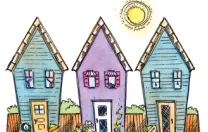For alternatives to the idealized, traditional lawn, try these options.
Fescues. Closely related to ryegrass, fescues often come mixed into lawn grass seed bags, but can be planted themselves for a wide range of effects. Some varieties are small and wispy, while others have a bolder look and help curtail soil erosion. They do not need fertilizers, herbicides, et cetera, to thrive. They are also fairly shade-tolerant and often grow in more interesting textures and forms than does Kentucky bluegrass.
Sedge lawns, which are increasing in popularity, need only one initial mowing a season (but can take more to create a more manicured look). They require no fertilizer or other chemicals, says Kristin Desouza, senior horticulturist with the New England Wildflower Society. The organization sells Carex pennsylvanica, the sedge variety native to the Northeast, which grows up to 10 inches tall, and withstands sun, shade, and a fair amount of trampling.
Meadows. The Society has also favored installing a native flower meadow. But Peter Del Tredici says urban and suburban gardeners need to know that establishing a really good-looking meadow takes work: "You cannot just buy a seed packet and sprinkle it on the soil and sit back." Meadows require soil preparation and consistent irrigation early on "or these little seeds all dry out." It's more effective to put in the plants themselves, although that is more expensive. But once in place, a meadow, even a small one, is natural, looks great, and attracts birds, butterflies, and bees. People can also walk in it, have picnics, or take a nap--but golf and soccer are out of the question.
Ground covers such as Pachysandra terminalis and Vinca minor can be a good solution as long as they can dominate the landscape. Otherwise, says Del Tredici, "weeding the ground covers is a lot more work than mowing the grass every two or three weeks."
Edible gardens. First lady Michelle Obama, J.D. '88, is among the increasing number of Americans bent on turning their turf into food. A National Gardening Association survey found that seven million more households planned to grow their own food in 2009 than in 2008, a rise of 19 percent. (See, as one example, the Edible Estates project, www.fritzhaeg.com/garden/ initiatives/edibleestates/main.html.)






